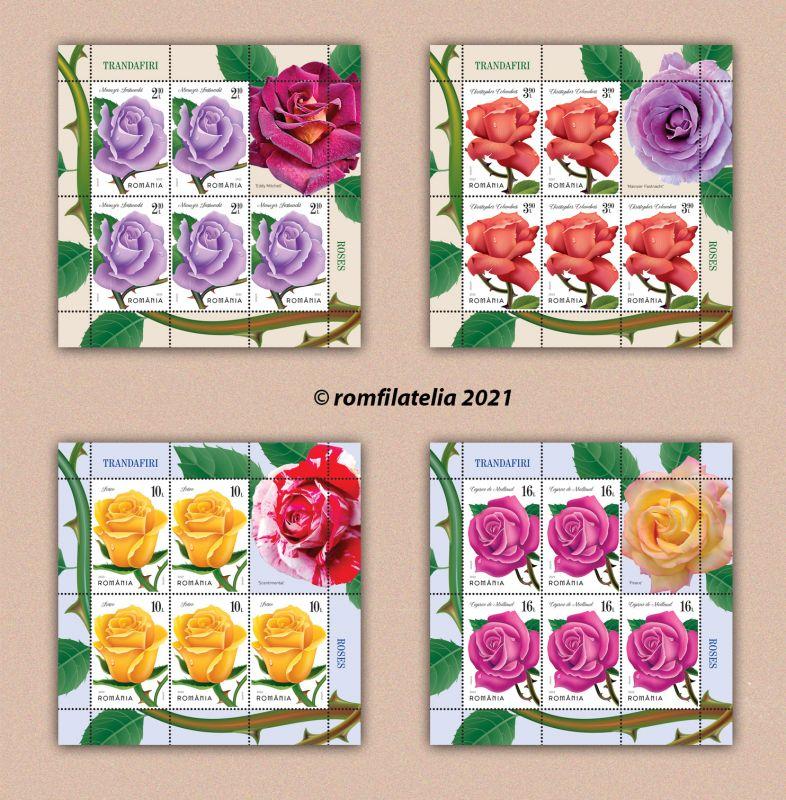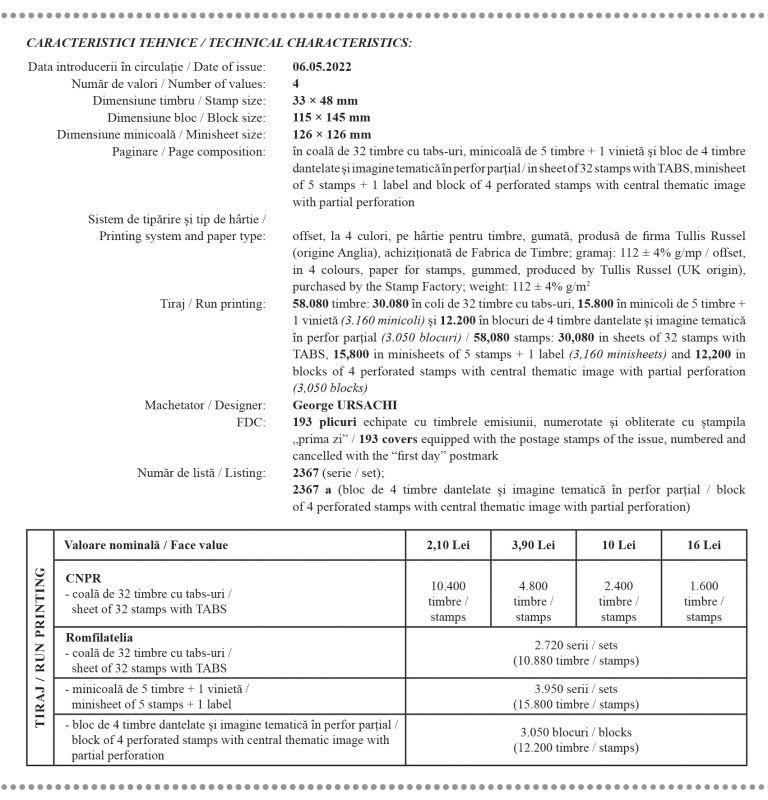 “I’d rather have roses on my table than diamonds on my neck”.
“I’d rather have roses on my table than diamonds on my neck”.
Emma Goldman
Romfilatelia continues the tradition of postage stamps issues with the Flora topic, introducing into circulation on Friday, May 6th, this year, the ROSES issue, consisting of four stamps, 4 minisheets
of 5 stamps with label, 4 sheets of 32 stamps with tabs, a block of four perforated stamps and thematic image with partial perforation and a First Day Cover.
The rose, through its wide range of colours and scents, has always been one of the most appreciated flowers, also being nicknamed the “Queen of Flowers”. Roses are indispensable in the decor of most parks. Roses attract by the tenderness of the flowers and the colour of the petals, but also by the varied perfume with aromas from fruits to spices; it is known that the moment someone receives a flower, she instinctively smells it. Roses have occupied and still occupy an important place in any landscaping design.
‘Mainzer Fastnacht’ Rosa, Mathias Tantau Jr., Germany 1964, Hybrid Tea, illustrated on the stamp with the value of Lei 2.10, is a variety of rose with medium-high vigour, with a growth of up to 120-150 cm and an opening of the bush of 40-50 cm. It has thin and not very thick shoots, with few spines. The leaves are small and sparse, dark green, semi-glossy. The buds are up to 5-6 cm long, slightly pointed. The flowers that appear solitary are beautiful, medium in size, with a diameter of up to 10-12 cm, rich in petals (30-40) and very elegant, with lavender-like purple-coloured petals, emitting a sweet scent with fine, very pleasant aromas of spices. This is one of the most popular “blue” varieties.
After each wave of flowers, it needs pruning to stimulate a new flowering, the last pruning being at the beginning of October, in order not to force the prolongation of the vegetation period. During the winter it needs protection (ridging).
‘Christopher Columbus’ Rosa, Meilland, France 1992, Hybrid Tea, represented on the stamp with a face value of Lei 3.90, is a variety of vigorous rose, with a height of 150-170 cm and an opening of the bush of 50-60 cm. It has erect shoots with many spines. The leaves are large, thick, dark green and glossy. The flowers appear more often solitary, but can also be grouped with a maximum of 3 flowers on the stem, wrapped, with 20-25 large petals, with a diameter of 14-15 cm, with red-orange petals at the beginning. The buds are slender and 4-5 cm high, the scent is faint.
After each wave of flowers, it needs pruning to stimulate a new flowering, the last pruning being at the beginning of October, in order not to force the prolongation of the vegetation period. During the winter it needs protection (ridging).
‘Frisco’ Rosa, Reimer Kordes, Germany 1986, Floribunda, rendered on the stamp with a face value of Lei 10.00, is a variety of rose with a growth of up to 80-100 cm and an opening of 50 cm, the shoots are erect, have spines in small numbers, the leaves are dark green, glossy. The buds are slender, with a height of 3-4 cm. The flowers have a diameter of 9-10 cm with 35-40 petals and appear on average 4-5 on the stem; the petals are bright yellow, being visible from a distance, a colour that persists throughout the flowering period. The scent is faint.
After each wave of flowers, it needs pruning to stimulate a new flowering, the last pruning being at the beginning of October, in order not to force the prolongation of the vegetation period. During the winter it needs protection (ridging).
‘Caprice de Meilland’ Rosa, Meilland, France 1997, Hybrid Tea, illustrated on the stamp with the value of Lei 16.00, is a variety of rose with good vigour, erect and long shoots reaching up to 150-180 cm in height and an opening of the bush around 50 cm. The leaves are dark green, medium in size and dull. The buds have a height of up to 5-6 cm. The flowers generally appear solitary, but can be 2-3 on the stem, are large, with a diameter of 15-16 cm and an average of 35 petals. The petals have a very attractive colour, dark pink-lilac, very delicate. The scent is something special, compared to many other roses that attract through the enveloping scent, i.e. it is felt from a distance.
After each wave of flowers, it needs pruning to stimulate a new flowering, the last pruning being at the beginning of October, in order not to force the prolongation of the vegetation period. During the winter it needs protection (ridging).
‘Scentimental’ Rosa, Tom Carruth, U.S.A. 1996, Floribunda, is a variety of rose with a growth of up to 90-120 cm and an opening of the bush of 60-80 cm. The leaves are semi-dark green, semi-glossy. The flowers, 10-12 cm in diameter and rich in petals (25-30), have a colour combination in which white, red and cream are found, mixed, almost no two petals alike. Some are red with white spots; others are cream stained with red. The scent is something that completes this picture with a sweet mix of spices. After each wave of flowers, it needs pruning to stimulate a new flowering, the last pruning being at the beginning of October, in order not to force the prolongation of the vegetation period. During the winter it needs protection (ridging).
‘Eddy Mitchell’ Rosa, Alain Meilland, France 2008, Hybrid Tea, is a variety of rose with a height of 120-140 cm and an opening not exceeding 60 cm. The shoots are strong with fairly large, dark green, glossy leaves. The large flowers with a diameter of 10-12 cm and 25-40 petals are something special, the upper part of the petals has at the beginning a shade of dark red velvet that changes almost to black, more precisely to old brandy. The lower part of the petals offers a very nice contrast, light yellow to cream or even gold. The scent is faint. After each wave of flowers,
it needs pruning to stimulate a new flowering, the last pruning being at the beginning of October, in order not to force the prolongation of the vegetation period. During the winter it needs protection (ridging).
‘Peace’ Rosa, Francis Meilland, France 1935 Hybrid Tea, rendered on the First Day Cover envelope of the issue, is a kind of rose with vigorous bushes with a growth of up to 120-170 cm and a plant opening of 50-90 cm, with semi-erect but straight branches. The leaves are dark green, thick and glossy. The flowers are magnificent, with delicate cream-yellow petals, brushed with pink on the edges, large, with a diameter of 14-16 cm, with 50-55 petals. The buds are spherical and open slowly. The scent is faint but pleasant. During the winter, it needs protection (ridging).
Despite the war, this rose was introduced to France as ‘Madame A. Meilland’, in memory of the mother of the French creator, Claudia, in Germany as ‘Gloria Dei’ and in Italy as ‘Gioia’. It was the most beautiful hybrid tea ever seen. In 1945, it was presented as ‘Peace’ and offered to the 49 delegates who met in San Francisco to form the United Nations (UN). Each rose was accompanied by a letter with the following words: “We hope that the ‘Peace’ rose will influence people’s thoughts for eternal world peace”. This is one of the most well-known and widespread varieties at present.
Romfilatelia thanks Prof. Paulina Anastasiu, Ph.D., Manager of “Dimitrie Brandza” Botanical Garden of the University of Bucharest and Eng. Marius Negulici, Ph.D. for the documentary and photographic support given to the development of this postage stamps issue.



